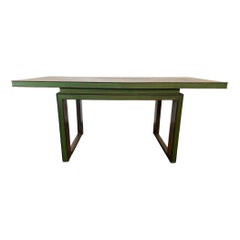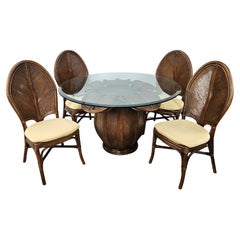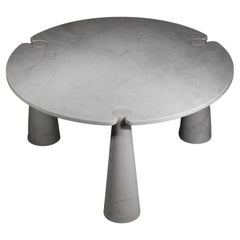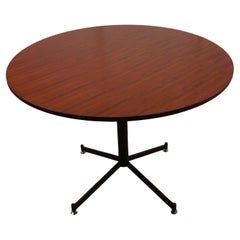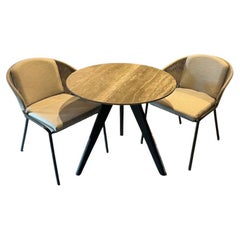Italian Dining Room Sets
to
31
Height
to
Width
to
Depth
to
149
45
170
23
4
91
19
18
2
2
1
1
1
1
2
8
160
27
6
89
53
1
5
8
26
25
34
11
126
81
51
33
29
691
312
293
197
104
197
176
183
8
6
5
5
5
Place of Origin: Italian
Table in Art Deco style in rosewood and green maple, 1940s
Located in Montelabbate, PU
Art Deco table with clean, rational lines. The rosewood base gives way on the front to green aniline-stained maple. The top is made of rosewood feather laid open. The piece showcases...
Category
1940s Art Deco Vintage Italian Dining Room Sets
Materials
Maple, Rosewood
$2,966 Sale Price
44% Off
Set with wicker and bamboo table and four chairs by Vivai Del Sud 1970s
By Vivai del Sud
Located in Premariacco, IT
Vintage 1970s garden or patio set with table and four comfortable bamboo chairs.
Note the quality of the items; the glass is 1cm thick.
Ideal as a vintage garden dining set or also...
Category
1970s Mid-Century Modern Vintage Italian Dining Room Sets
Materials
Bamboo, Wicker, Glass
Tripod Dining Table in Carrara Marble Angelo Mangiarotti Model Eros
By Angelo Mangiarotti
Located in Ternay, Auvergne-Rhône-Alpes
Beautiful tripod dining table model "Eros" from the Italian designer Angelo Mangiarotti from the 70s. The legs (independent) and the top are in Car...
Category
1970s Organic Modern Vintage Italian Dining Room Sets
Materials
Carrara Marble
Customizable La Manufacture-Paris Amazone Table & Poufs Designed by Atelier Oï
By Atelier Oï 1
Located in New York, NY
Variant 1 — Composed by 4 pouf and a top in walnut wood.
Pouf can be sold individually.
Table can be with 2 poufs.
Different top options.
Different upholstery materials available. Price listed for starting fabric.
The Amazone collection is designed by Atelier oi...
Category
2010s Italian Dining Room Sets
Materials
Textile
Vittorio Nobili Mid-Century Teak Medea Table, 1956
By Vittorio Nobili
Located in Vicenza, IT
Medea dining circular table, designed by Vittorio Nobili for Fratelli Tagliabue in 1954.
Made of teak iron and brass, excellent vintage condition.
Reported at “Compasso d’Oro Prize...
Category
1950s Mid-Century Modern Vintage Italian Dining Room Sets
Materials
Iron
Manutti Table & Radoc Chairs Outdoor Set
Located in Boston, MA
Manuttii Outdoor Table & Radoc Chair set.
Manuttii Torsa Table in brushed teak nero & travertin geo
Designed by Stephane De Winter
Torsa is the epitome of sophistication: slender...
Category
2010s Modern Italian Dining Room Sets
Materials
Aluminum
$5,600 / set
Osvaldo Borsani Italian Mahogany Ebonized Dining Table, circa 1950
By Osvaldo Borsani
Located in Rovereta, Repubblica di San Marino
A beautifully ebonized mahogany and rose marble dining table by Arredamenti Borsani Varedo,whit original label, Italy, circa 1950. The wonderf...
Category
Mid-20th Century Mid-Century Modern Italian Dining Room Sets
Materials
Wood
Ometto-260 Dining Table with Walnut Base and Rectangular Glass Top by Zanaboni
By Zanaboni
Located in MEDA, IT
Ometto Modern Italian dining table with Canaletto walnut solidwood bases and crystal glass top
Measure: Total length cm 260.
Please Note:
- If the item is to be shipped to the USA,...
Category
21st Century and Contemporary Art Deco Italian Dining Room Sets
Materials
Wood
Vittorio Nobili Midcentury Ash Wood Medea Dining Room Chairs, 1956, Set of Four
By Vittorio Nobili
Located in Vicenza, IT
Set composed of four Medea dining chairs, designed by Vittorio Nobili for Fratelli Tagliabue in 1954.
Made of ash plywood, excellent vintage condition.
Reported at “Compasso d’Oro ...
Category
1950s Mid-Century Modern Vintage Italian Dining Room Sets
Materials
Iron
1970-1980 Dining Room Guido Faleschini for Hermès or Roche Bobois
By Guido Faleschini
Located in Paris, FR
1 side board with two smoked windows, strap handles and chrome metal support, lacquered black marble top, sides and rear are covered with black felt and a table with sliding tray 87 X 120 X H 73 cm becoming 241cm trademark has Milano and 6 chrome chairs...
Category
1970s Space Age Vintage Italian Dining Room Sets
Materials
Metal
1960s Mario Bellini Design First Edit Scacchi Two "Horse" C&B Italy
By Mario Bellini
Located in Biella, IT
Mario Bellini design first edit two horse "scacchi" for C&B italy production years 1968
this is very rare set first edition from C&B Italy and not for the after b&b.
auction ...
Category
1970s Modern Vintage Italian Dining Room Sets
Materials
Acrylic
Dining Set for 3 People, 1970, Set of 4
Located in Montelabbate, PU
A solution for upper middle-class furnishing, with effect and impact. Visible quality and elegance of design. The set for three persons consists of: a table H 48 cm x diameter 119 cm...
Category
1970s Vintage Italian Dining Room Sets
Materials
Steel
$2,373 / set
Vintage Giancarlo Vegni for Fasem Italy Leather Woven Net Dining Chairs & Table
By Giancarlo Vegni, Fasem International
Located in West Sussex, Pulborough
We are delighted to offer for sale this exceptionally rare original vintage Giancarlo Vegni designed for Fasem Italy dining table and Net chair suite
A very good looking and well ...
Category
20th Century Mid-Century Modern Italian Dining Room Sets
Materials
Chrome
Midcentury Italian Set of 4 Chairs and Marble Table, 1980s
Located in Los Angeles, CA
The midcentury Italian set of four chairs and marble table from the 1980s offers a blend of sophistication and luxury. The chairs have been thoughtfully reupholstered in green suede,...
Category
1980s Mid-Century Modern Vintage Italian Dining Room Sets
Materials
Marble, Metal, Brass
Midcentury Italian Set of 4 Chairs and Table, 1970
Located in Los Angeles, CA
The midcentury Italian set of four chairs and table from the 1970s, crafted in giunco wood, exudes a rustic charm and timeless elegance. The chairs feature a stylish and ergonomic de...
Category
1970s Mid-Century Modern Vintage Italian Dining Room Sets
Materials
Rush
Tablecloth by Davide Medri
Located in Geneve, CH
Tablecloth by Davide Medri
Materials: mirror mosaic (silver)
Also available in gold.
Dimensions: H 90 x D 120 cm
Davide Medri was born in Cesena on August 7th 1967 and graduated at ...
Category
2010s Modern Italian Dining Room Sets
Materials
Mirror
$7,989 / item
Giorgio Collection Huge Extending Burr Satinwood Dining Table Suite
By Giorgio Collection
Located in West Sussex, Pulborough
We are delighted to offer this very fine original RRP £12,000 extra large Burr Satinwood Giorgio Collection extending dining table
This piece is part of a monumental £50,000+ dining room suite which includes the extra large extending table...
Category
20th Century Mid-Century Modern Italian Dining Room Sets
Materials
Satinwood
